Kia Sorento
Front Brake Pads Replacement Guide
How to change the front disc brake pads
on a 3rd generation 2016, 2017, 2018, 2019 and 2020 Kia Sorento.
By Paul B. Michaels Author & Photographer Auto Mechanic Since 1989 |
||
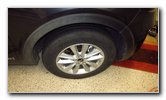 2019 Sorento Front Wheel |
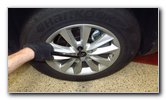 Slightly Loosen Lug Nuts |
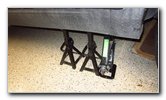 Raise Front of Vehicle |
|
This automotive maintenance tutorial was specifically written to assist owners of the third generation (2016, 2017, 2018, 2019 and 2020) Kia Sorento SUV in changing the front disc brake pads and lubricating the caliper slider pins including directions for changing the rotors. Owners of other Kia, Hyundai and Genesis vehicles such as the Soul, Seltos, Sportage, Niro, Telluride, Forte, Rio, Optima, Stinger, Cadenza, K900, Sedona, Kona, Venue, Santa Fe, Elantra, Sonata, Accent, Veloster, Ioniq, Nexo, G70, G80 and G90 may also find these instructions to be helpful. A few compatible sets of new front brake pads with their part numbers include the following: Power Stop 17-1432, Callahan CPK11370, Wagner QC1815 and ACDelco 14D1815CH. The tools and other items needed to complete this procedure include a lug nut wrench, a floor jack, two jack stands, a 14mm socket with a 3/8" drive ratchet, an "F" clamp and a tube of brake caliper grease. The first few steps are to drive the SUV on to a level surface, shift the transmission into "Park" and turn off the ignition. Engage the emergency / parking brake and place wheel chocks on both sides of the rear tires to help prevent the vehicle from moving. Slightly loosen the five lug nuts on the front wheel by turning them about 1/4 to 1/2 of a turn in the counterclockwise direction with the lug nut wrench. Carefully raise the front of the SUV with the floor jack and securely support it with at least two jack stands. Please do NOT solely rely on the floor jack to support the vehicle! I prefer to only work on one side of the car at a time to keep three tires on the ground for extra safety. |
||
|
|
||
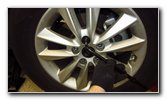 Spin Off Lug Nuts |
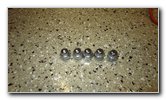 Five Lug Nuts Removed |
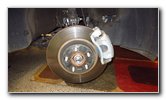 Rotor, Bracket, Caliper |
| Spin off the five
lug nuts and set them aside in a safe place. Carefully remove the front wheel and set it aside. Some home mechanics prefer to place the wheel and tire under the frame rail of the vehicle as an extra backup support device just in case the floor jack and jack stands fail. Once the wheel and tire have been removed, you'll be able to see the rotor, bracket, caliper and suspension. |
||
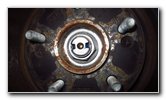 Two Rotor Set Screws |
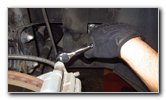 Loosen Top Caliper Bolt |
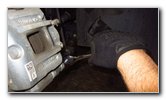 Loosen Bottom Bolt |
| If you also plan on
replacing the rotors, keep in mind that there are two Phillips head set
screws on the outer face of the rotor. Loosen the top caliper bolt by turning it in the clockwise direction (as seen from the outside of the vehicle) with the 14mm socket and a 3/8" drive ratchet. Then loosen the bottom caliper bolt by turning it in the clockwise direction (when viewed from the outside of the car) with the 14mm socket and the 3/8" drive ratchet. |
||
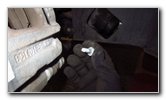 Spin Out Lower Bolt |
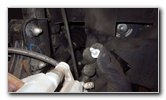 Spin Out Bottom Bolt |
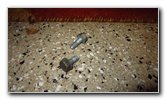 Two Bolts Removed |
| Spin out the two caliper bolts and set them aside in a safe place. | ||
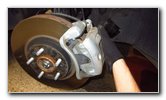 Lift Caliper Off Pads |
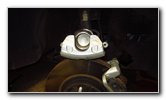 Rest Caliper On Rotor |
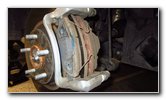 Two "V" Spring Clips |
| Carefully lift the
caliper out of the bracket and off the old brake pads. Rest the caliper on the rotor or suspend it from the suspension spring with a bungee cord or some rope. Try to avoid kinking, bending, stressing or pulling on the rubber brake fluid hose. The OEM (original equipment manufacturer) brake pads are equipped with two "V" shaped metal brake pad drag reduction spring clips. These metal spring clips held spread the two brake pads away from the rotor to reduce friction and improve fuel economy while you are not actively braking. |
||
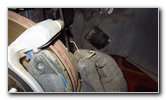 Pull Off Top Spring Clip |
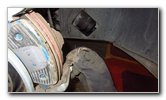 Remove Lower Spring Clip |
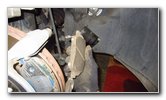 Wear Bar - Top Inner Pad |
| Pull the two spring
clips off the outer edge of the old brake pads. If your new set of pads includes new spring clips, you can discard the old ones. If not, set the old clips aside for re-installation later on. Pull the old brake pads out of the bracket. Make a mental note of where the wear indicator or "squeal" bar was situated on the old pads. On this 2019 Sorento, the wear indicator bar was located at the top of the old inner brake pad. |
||
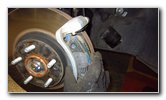 Remove Old Outer Pad |
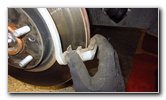 Pad Abutment Clips |
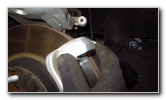 Replace Abutment Clips |
| If your new set of
front pads includes a bog of replacement hardware, remove the old pad
abutment clips or "anti-rattle" clips from the top and bottom of the
bracket. Clean off the rotor, bracket, caliper and lug studs with brake parts cleaner spray. Apply a thin layer of brake caliper grease to the top and bottom of the new pad abutment clips where they will come in contact with the bracket or the new pads. Push the new pad abutment clips into the top and bottom of the bracket. Make sure the two clips are fully seated. Do not get any grease on the friction surface of the new pads or the rotor. |
||
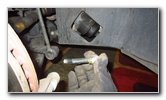 Pull Out Slider Pin |
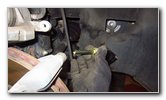 Lubricate & Replace Pins |
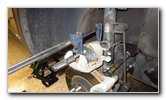 Attach "F" Clamp |
| In order for the
caliper to operate smoothly, the two caliper slider pins need to be well
lubricated. Do not mix up the top and bottom caliper slider pins since they are slightly different. Pull out one pin at a time from the rubber dust boot attached to the bracket. Apply a thin layer of brake parts lubricant grease to the smooth part of the pin and push it back into the bracket. Repeat the process for the other pin. In order for the caliper to fit over the thicker new brake pads, the caliper piston needs to be compressed back or "retracted". Attach the "F" clamp to the caliper and use the back of an old brake pad to evenly distribute the pressure across the piston. Avoid placing the F clamp over the brake fluid hose attachment. |
||
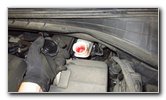 Remove Brake Fluid Cap |
 Compress Caliper Piston |
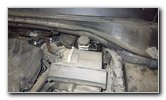 Replace Reservoir Cap |
| Move to the right
rear area of the engine bay. Twist off the round black plastic cap on the brake fluid reservoir by turning it in the counterclockwise direction. Set the cap aside in a safe place. Slowly turn the "F" clamp's handle in the clockwise direction to compress back the caliper piston. Try to avoid pinching or otherwise damaging the rubber dust boot that surrounds the piston. Repeatedly check the fluid level in the reservoir to make sure it doesn't overflow. When you are done compressing the caliper piston, replace the brake fluid reservoir cap. Brake fluid is hygroscopic (easily absorbs moisture from the air), so the cap shouldn't be left off any longer than necessary. If the brake fluid becomes contaminated with water, it may reduce the boiling point of the brake fluid and lead to reduced braking performance. |
||
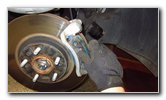 Install New Outer Pad |
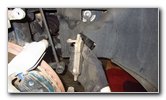 Wear Bar - Top Inner Pad |
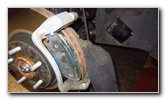 Install New Inner Pad |
| If you would like
to install new rotors, remove the two 17mm bolts on the back side of the
bracket and set the bracket aside in a safe place. Then remove the two Phillips head set screws on the outer face of the rotor by turning them in the counterclockwise direction. Slide the old rotor off the wheel hub. If you have trouble removing a stubborn or rusted on old rotor, try hitting it with a rubber mallet to loosen the rust or debris. Slide the new rotor over the lug studs, replace the two set screws and re-attach the bracket with the two 17mm bolts. If you have a torque wrench, the Kia Sorento service manual specification for tightening the two 17mm bracket bolts is a range of 57.9 to 72.3 lb-ft of torque. A few compatible front brake rotors with their part number are as follows: ACDelco 18A81010A, Raybestos 981010R and DuraGo BR901184-02. The wear indicator bar should be situated on the top of the inner brake pad. Install the two new brake pads into the bracket. |
||
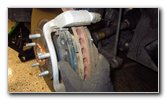 Push Pads Against Rotor |
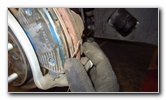 Install Lower Spring |
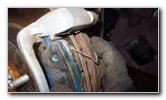 Attach Upper Spring |
| Push the two new
pads against the rotor. If your new pads are equipped with the small holes on the outer edge, install the new "V" shaped drag reduction spring clips. Or re-use your old spring clips if new ones were not included. |
||
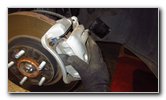 Lower Caliper Over Pads |
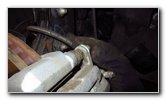 Spin In Top Bolt |
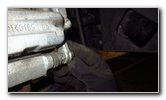 Spin In Bottom Bolt |
| Carefully lower the
caliper over the new pads and into the bracket. If the caliper won't fit over the new pads, you may need to compress the piston back a bit more. Line up the bolt holes in the caliper with their corresponding bolt holes in the slider pins within the bracket. Spin in the two bolts a few turns by hand in the counterclockwise direction (as seen from the outside of the vehicle). |
||
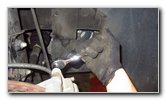 Tighten Upper Bolt |
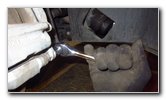 Tighten Lower Bolt |
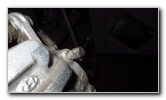 Rubber Valve Cap |
| Tighten the two
caliper bolts by turning them in the counterclockwise direction (when viewed
from the outside of the car) with the 14mm socket and a 3/8" drive ratchet. If you have a torque wrench, the service manual torque specification for the caliper bolts is a range of 15.9 to 23.1 lb-ft of torque. Double check that the two caliper bolts are tight before moving on to the next steps. If your brake pedal has been feeling very soft or spongy, you may need to bleed the brake lines in order to remove any air bubbles or moisture. Check out my Acura MDX Brake Fluid Bleeding Guide for more information on this procedure. In general, you will need to bleed the brake lines from the furthest wheel from the brake fluid reservoir to the closest one. The brake fluid bleeder valve is located just below the top caliper bolt underneath a rubber cap. You'll need a 10mm wrench to open and close the bleeder valve. |
||
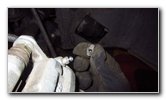 Brake Fluid Bleeder Valve |
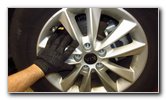 Push On Front Wheel |
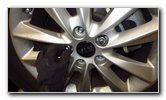 Spin On Five Lug Nuts |
|
Carefully push the front wheel back into place over the lug studs. Spin on the five lug nuts a few turns by hand in the clockwise direction to prevent them from becoming cross threaded. |
||
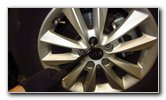 Slightly Tighten Lug Nuts |
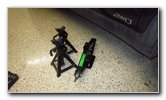 Lower Car From Stands |
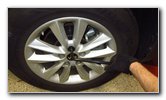 Torque Lug Nuts |
| Slightly tighten
the lug nuts in the clockwise direction with the tire iron in a criss-cross
or a star pattern. Carefully lower the SUV from the jack stands by using the floor jack. Continue progressively tightening the five lug nuts in the clockwise direction to about 1/8th of a turn past hand tight.
It would be best to use a torque wrench to tighten the lug nuts to the 2019 Kia Sorento AWD owner's manual specification of 79 to 94 lb-ft of torque. The 2017 Sorento has a wheel nut tightening torque specification of 65 to 79 lb-ft of torque. Again, please check your owner's manual to verify the correct lug nut torque specification for your vehicle. Sit in the driver's seat and firmly press the brake pedal several times to restore the brake line pressure. I would also recommend checking your driveway, parking spot or your garage for drops of brake fluid which might indicate a leak from the bleeder valve or the reservoir bottle. Check the fluid level in the reservoir and if necessary, add more DOT 3 or DOT 4 fluid until it reaches the "MAX" (maximum) level. Be sure to write down the front brake job in your vehicle's service records. Please
take a look at
all of my
2016-2020 Kia Sorento DIY Repair & Maintenance Guides. |
||
| If you found this guide to be helpful,
please consider making a small donation by clicking on the PayPal.com
"Donate" button located to the right of this paragraph. Thank you!
(Note: I am not a registered charity. Donations are not tax deductible.) |

